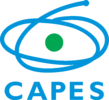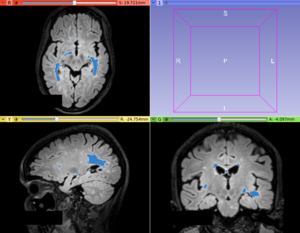Difference between revisions of "Documentation/Nightly/Extensions/LesionSpotlight"
Acsenrafilho (talk | contribs) (First edition in the LesionSpotlight Extension.) |
Acsenrafilho (talk | contribs) m |
||
| Line 27: | Line 27: | ||
[[Image:LesionSpotlight-logo.png|left]] | [[Image:LesionSpotlight-logo.png|left]] | ||
| − | ... <ref> | + | This extension provides image segmentation and enhancement approaches in order to increase the abnormal white matter voxels in magnetic resonance images. At moment, there are available the LS Segmenter module (specific for hyperintense Multiple Sclerosis lesion segmentation on T2-FLAIR images) and LS Contrast Enhancement Module (specific to increase the contrast of abnormal voxels of the same T2-FLAIR images). The LS Contrast Enhancement module can be used as an image enhancement pre-processing step before a future lesion segmentation algorithm (which could be used any other approach, such as LesionTOADS, OASIS or LST). The LS Segmenter module implements a hyperintense T2-FLAIR lesion segmentation based on the algorithm published in the paper Cabezas, M. et al<ref>Cabezas, M. et al (2014) "Automatic multiple sclerosis lesion detection in brain MRI by FLAIR thresholding", Computer Methods and Programs in Biomedicine, DOI: 10.1016/j.cmpb.2014.04.006.</ref>. |
| − | + | '''NOTE''': The Logistic Contrast Enhancement, Weighted Enhancement Image Filter and Automatic FLAIR Threshold modules are only supporting CLI methods added here to apply part of the other modules. For this reason these modules are not supposed to be used alone. Please, use the LS Contrast Enhancer or LS Segmenter modules only. | |
<!-- ---------------------------- --> | <!-- ---------------------------- --> | ||
| Line 42: | Line 42: | ||
**Hyperintense Multiple Sclerosis lesions, mainly in T2-FLAIR images, have a easy application of this segmentations procedure. | **Hyperintense Multiple Sclerosis lesions, mainly in T2-FLAIR images, have a easy application of this segmentations procedure. | ||
* Use Case 2: Increase contrast in abnormal voxels in white matter | * Use Case 2: Increase contrast in abnormal voxels in white matter | ||
| − | ** | + | **There are some lesion segmentation approaches that relies on the voxel intensity level presented in the lesion signal, where the LS Contrast Enhancer module can be helpful to increase the contrast between lesions and surrounding brain tissues (mainly White Matter). |
| − | <gallery widths=" | + | <gallery widths="300px" heights="300px" perrow="3"> |
| − | Image: | + | Image:T2FLAIR_patient.png|T2-FLAIR image from a MS patient |
| − | Image: | + | Image:T2FLAIR_patient_lesionLabel.png|T2-FLAIR hyperintense lesion segmentation provided by the LS Segmenter module |
| − | Image: | + | Image:Lesion3DRender.png|Lesion and White Matter 3D representation |
| + | Image:T2FLAIR_beforeContrast.png|T2-FLAIR image with original lesion contrast | ||
| + | Image:T2FLAIR_afterContrast.png|T2-FLAIR image with hyperintense lesion contrast enhanced provided by the LS Contrast Enhancer module | ||
</gallery> | </gallery> | ||
Revision as of 15:19, 9 December 2016
Home < Documentation < Nightly < Extensions < LesionSpotlight
|
For the latest Slicer documentation, visit the read-the-docs. |
Introduction and Acknowledgements
|
This work was partially funded by CAPES and CNPq, a Brazillian Agencies. Information on CAPES can be obtained on the CAPES website and CNPq website. | |||||||||
|
Extension Description
This extension provides image segmentation and enhancement approaches in order to increase the abnormal white matter voxels in magnetic resonance images. At moment, there are available the LS Segmenter module (specific for hyperintense Multiple Sclerosis lesion segmentation on T2-FLAIR images) and LS Contrast Enhancement Module (specific to increase the contrast of abnormal voxels of the same T2-FLAIR images). The LS Contrast Enhancement module can be used as an image enhancement pre-processing step before a future lesion segmentation algorithm (which could be used any other approach, such as LesionTOADS, OASIS or LST). The LS Segmenter module implements a hyperintense T2-FLAIR lesion segmentation based on the algorithm published in the paper Cabezas, M. et al[1].
NOTE: The Logistic Contrast Enhancement, Weighted Enhancement Image Filter and Automatic FLAIR Threshold modules are only supporting CLI methods added here to apply part of the other modules. For this reason these modules are not supposed to be used alone. Please, use the LS Contrast Enhancer or LS Segmenter modules only.
Modules
Use Cases
Most frequently used for these scenarios:
- Use Case 1: Multiple Sclerosis (MS) hyperintense lesions segmentation
- Hyperintense Multiple Sclerosis lesions, mainly in T2-FLAIR images, have a easy application of this segmentations procedure.
- Use Case 2: Increase contrast in abnormal voxels in white matter
- There are some lesion segmentation approaches that relies on the voxel intensity level presented in the lesion signal, where the LS Contrast Enhancer module can be helpful to increase the contrast between lesions and surrounding brain tissues (mainly White Matter).
Similar Extensions
N/A
References
- paper
Information for Developers
| Section under construction. |
Repositories:
- Source code: GitHub repository
- Issue tracker: open issues and enhancement requests
- ↑ Cabezas, M. et al (2014) "Automatic multiple sclerosis lesion detection in brain MRI by FLAIR thresholding", Computer Methods and Programs in Biomedicine, DOI: 10.1016/j.cmpb.2014.04.006.









